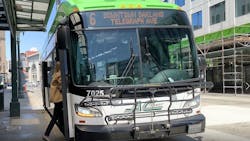AC Transit releases its first Zero-Emission Transit Bus Technology Analysis study
The Alameda-Contra Costa Transit District (AC Transit), with Stanford University's Precourt Institute for Energy, published its Zero-Emission Transit Bus Technology Analysis (ZETBTA) study, which created a "scholarly reinforced roadmap to aid transit agencies in planning, procurement, training and, most importantly, a guide to curtailing costly missteps toward zero-emission conversions."
Although the coronavirus pandemic disrupted transportation networks globally, most public transit systems were deemed essential. AC Transit specifically was regarded as critical to the San Francisco Bay Area’s East Bay infrastructure. As a result, the transit district used the extraordinary months of the pandemic to launch this first-of-its-kind analysis of transit bus propulsion systems.
“Our board of directors began exploring zero-emission technologies two decades ago. But we wanted much more than to report assumptions about metrics and formulas,” said AC Transit Board Director Chris Peeples. “To successfully implement a zero-tailpipe emissions fleet, I felt it was critical to validate our findings. Stanford’s independent analysis offers transparency and accuracy for a roadmap the transit industry can now rely on.”
The ZETBTA is a robust side-by-side evaluation of the predominant engine technologies in use at transit agencies worldwide: fuel-cell electric bus (FCEB), battery electric bus (BEB), diesel hybrid and conventional diesel bus propulsion systems.
“AC Transit currently operates all five propulsion technologies and is uniquely positioned to support this rigorous study,” said AC Transit General Manager Michael Hursh. “For long range planners, this is an unrivaled collection of years of research, transit planning and design; made stronger because the propulsion metrics are not cobbled from several sources but instead one agency, with roadway testing on the same routes, and in the same service environment.”
The study launched in July 2020 and integrated lessons learned and best practices gleaned from the agency's experience deploying ZEB technologies, including the development of innovative workforce training programs, data integration and management and transit deployment viability.
This initial iteration of the ZETBTA will help transit agency leaders understand step-by-step the capital cost, performance and operating cost between ZEB types when comparing performance to conventional diesel bus technologies. The study is also a collection of energy data to develop metrics for costs, mileage, reliability and availability.
Admittedly, ZETBTA, even as an acronym, is a tongue twister. So, the team of technicians nicknamed it “The 5-by-5 (5X5) Study” because of its control group: five conventional diesel, five diesel hybrid, five electric FCEB, five BEB and five legacy FCEB, totaling 25 buses.
Initial study summary
From July 2020–December 2020, the FCEB had the highest fleet mileage (112,233), conversely, the BEB had the lowest mileage (64,648). The BEB had the lowest cost per mile (CPM) when applying warranty and low carbon fuel standard (LCFS) credits ($0.78). However, the legacy FCEBs had the highest CPM ($2.82), as they were outside the warranty period. The diesel fleet was the most reliable (15,226 MBCRC) and available (94 percent). However, the diesel fleet produced the most carbon emissions (275 CO²). The legacy FCEB fleet was the least reliable (3,024 MBCRC), and the BEB was the least available (57 percent).
In-use availability
Despite AC Transit’s zero-emission experience, the ZETBTA study documents that unanticipated conditions can and in most environments will arise during the deployment of advanced technology.
For instance, the hybrid fleet experienced reduced mileage during the study’s first three months, due to decreased availability. Low availability of the BEB fleet resulted in drastically reduced miles compared to the other fleets in the analysis. The legacy FCEB fleet remained consistent in the number of miles but below the expected total miles. The diesel and FCEB fleet remained constant during the testing period. Additionally, mileage on zero-emission and diesel-hybrid buses can decrease in months when there are operator sign-ups.
The BEB fleet experienced periods of out-of-service due to high-voltage battery issues resulting in the vehicles' 57 percent availability on the planned workdays. The hybrid and legacy FCEB fleets achieved an average availability of 85 percent due to defects that occurred throughout the test period. The diesel and FCEB fleets both averaged over 90 percent availability.
As a result, it is important to note that some of the results of this initial iteration do not reflect what will become a standard performance matrix.
What's next for ZETBTA (5X5 Phase II)
AC Transit’s collection of real-time performance data and its analysis by Stanford University has continued. A second review period with an identical control fleet is being conducted January 2021 through July 2021. AC Transit says the second iteration of "5x5” study promises more robust data sets as initial study deployment challenges are addressed, and riders return following the lifting of pandemic restrictions by the state of California. Study results are anticipated in winter 2021.
The full study is available for viewing on AC Transit's website.



